Menu
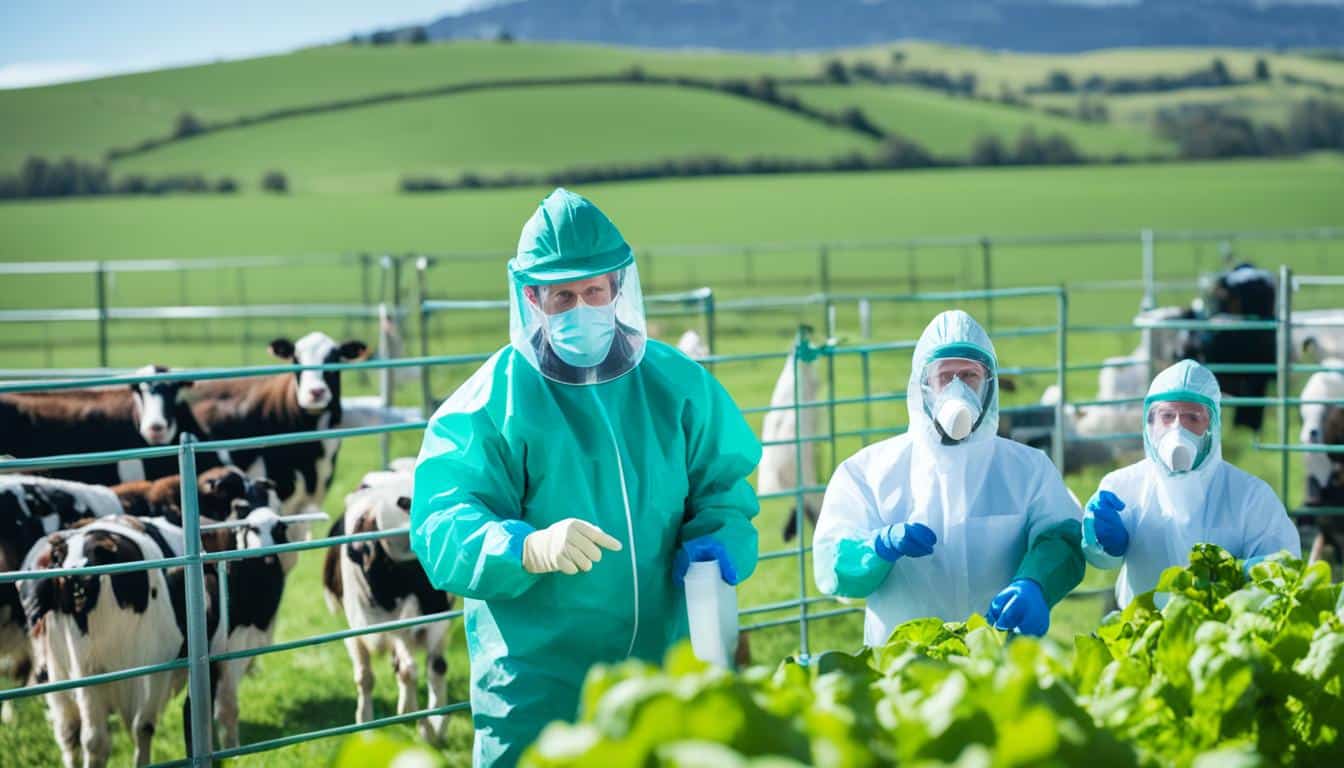
Did you know, African swine fever causes losses of USD 6.5 to 21 billion a year globally? This huge number shows how serious disease outbreaks in livestock are. It points out the massive harm these diseases do to the world’s farm animals. Managing these diseases well is vital to lessen their effects.
The Emerging Animal Infectious Disease Conference happened at Pennsylvania State University from 29 November to 1 December 2021. It brought top experts together to talk about this big issue. The meeting highlighted the big role of biosecurity in farms to stop new diseases from spreading. It looked at what we’ve learned from fighting serious animal diseases in the past, and how to get ready for future outbreaks. They decided we should make better ways to find disease and use a team approach of One Health to protect farm animals better.
Livestock diseases pose big challenges for both animals and humans. They put our food and economy at risk worldwide. A recent study showed how important livestock is for meat, dairy, and eggs. It predicts we’ll need more of these products in the future. So, controlling livestock diseases is key for everyone’s growth, especially in poorer areas.
Taking care of animal health is crucial to prevent diseases that can destroy herds and stop food production. In dairy farming, illnesses like respiratory disease can slow down a heifer’s growth and affect when she can start having calves and how much milk she makes.
Problems with the feet in cows can reduce their ability to have calves, how long they live, and how much milk they produce. Diseases like subclinical ketosis in dairy cows affect not just the cows but also the money farmers make. In Africa, diseases like foot-and-mouth and others harm farmers who rely on livestock for food and income. This is why stopping disease outbreaks is so important.
When livestock get sick, it costs a lot of money. The avian flu outbreak in the U.S. in 2014-2015 meant a $3.3 billion loss for the poultry industry. A virus called PEDv made the U.S. lose 8 million pigs in a year. The U.S. pig industry spends $664 million every year fighting the PRRS virus. In the U.K. in 2001, a foot-and-mouth outbreak forced the country to kill 6.5 million animals. This shows the huge impact such diseases can have.
Stopping livestock diseases requires everyone working together. Farmers, scientists, and the government must team up. They work to prevent deadly diseases like avian flu and foot-and-mouth. When they work together, they protect farms and worldwide food supplies.
| Disease | Economic Impact | Effect on Livestock |
|---|---|---|
| Highly Pathogenic Avian Influenza (HPAI) | $3.3 billion (U.S.) | Loss of nearly 50 million birds |
| Porcine Epidemic Diarrhea virus (PEDv) | 8 million animals lost (U.S.) | Significant loss of swine population |
| Porcine Reproductive and Respiratory Syndrome (PPRS) | $664 million annually (U.S.) | Ongoing economic strain on swine industry |
| Foot-and-Mouth Disease (FMD) | $6 billion (U.K. 2001) | Culling of 6.5 million animals |
Large-scale animal diseases challenge farm disease control because they spread fast and cross borders. They endanger both public health and cause economic and trade issues.
Pathogens in these outbreaks are strong and spread quickly. They can move from animal to animal, through things like water or feed, or by insects. Keeping diseases away in livestock is vital. This is done through strict biosecurity. For example, African swine fever started in China and went worldwide. There’s also the case of HPAI, which affected birds from the UK to Asia.
Looking back at cases like the 2001 Foot and Mouth Disease in the UK shows the high cost. This outbreak affected a lot of farms and a big part of the UK economy. The U.S. faced a massive bird loss in 2014-2015, costing billions. The government had to spend a lot to stop it.
Such events show the big economic effects of these outbreaks. The spread of ASF and HPAI H5N8 underlines the need for better vaccines. And they show how important high biosecurity is. We learn from the past that stopping these diseases needs a quick and united approach.
| Outbreak | Location | Economic Impact |
|---|---|---|
| Foot and Mouth Disease (2001) | United Kingdom | $6 billion |
| Avian Influenza (2014-2015) | United States | $3.3 billion (industry loss) + $610 million (government containment) |
| Classical Swine Fever (1993-1994) | Germany, Netherlands | $5 billion per country |
In the end, outbreaks like these cost a lot. It’s key to control and prevent them in livestock. This will help reduce their big impact.
It’s crucial to have strong biosecurity in livestock to stop disease spread. Measures like good fences and clean tools help a lot. The EAIDC showed the importance of these steps, especially in good vaccination plans and fence building.
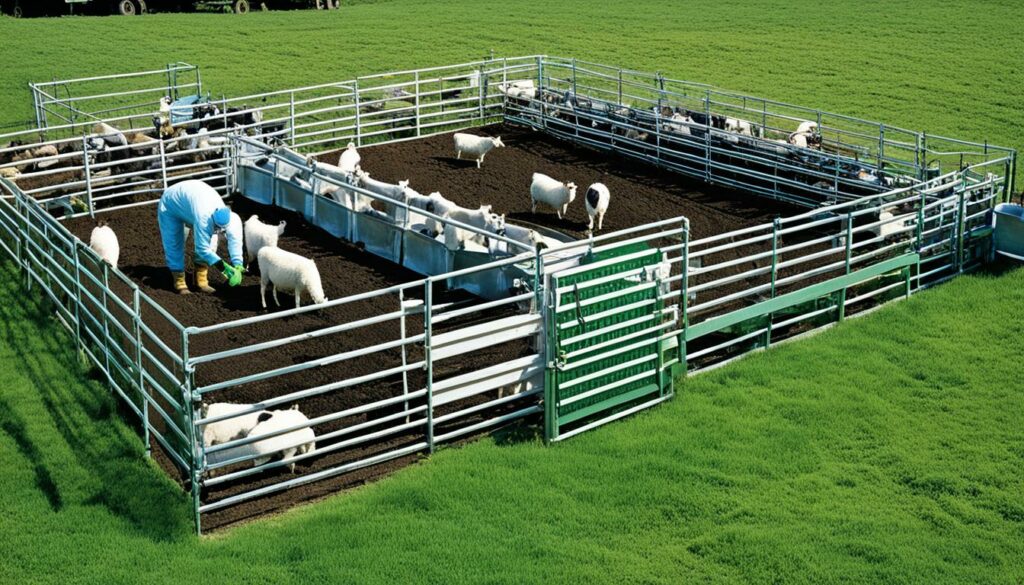
Making sure diseases don’t spread is key in livestock care. Good fences keep sick animals away from others. Also, cleaning transportation tools well matters a lot for farm health.
Being careful with biosecurity rules is very important. Youssef and colleagues found fewer bacteria in people near livestock when stricter rules were followed. This shows how much good rules can help everyone stay healthy.
Horillo’s study on pig farms in Spain shows that farmers must be active in keeping their farms safe. They need to care about and follow these rules closely.
There are some important stats that show us how vital biosecurity is:
| Study | Focus | Results |
|---|---|---|
| VanderWaal and Deen (2018) | Global trends in infectious diseases of swine | 11500 mentions on biosecurity importance |
| Postma et al. (2016) | Biosecurity status and antimicrobial usage | 12000 farms studied |
| Raasch et al. (2018) | Antimicrobial usage and biosecurity measures | 1000 observations on German farms |
At the EAIDC, experts said that good biosecurity is essential for more than disease control. It’s also key for getting ready for emergencies. Doing regular checks and keeping new animals separate can stop big health problems.
Also, research by Tenorio (2022) shows that controlling diseases that can jump to people is very important. When everyone works together to follow strict biosecurity rules, it makes both animals and people healthier.
Managing disease outbreaks in livestock is key to keep animals safe and prevent big financial losses. To do this well, we need to find sick animals quickly and know what’s making them ill. The U.S. faced a big loss in the 2014-2015 avian flu outbreak, losing nearly 50 million birds. This shows how vital it is to have strong plans for dealing with diseases.
Finding diseases early in livestock is vital to stop them from spreading and causing harm. Checking on what the animals eat, drink, and how they act can show if something’s wrong. Talking to vets as soon as a problem is suspected is important for getting a quick and correct diagnosis. Diseases like Porcine Epidemic Diarrhea virus (PEDv) led to losing 8 million animals in the U.S. in just one year. This highlights the urgent need for fast and accurate detection.
Acting quickly when a disease is found in animals is crucial to stop it from spreading widely. During the avian flu outbreak, the U.S. spent a lot of extra money to try and control it. Fast response efforts must also include isolating sick animals or farms, to stop the disease from moving further. Reporting these health concerns to the right authorities promptly helps prevent more widespread damage.
Vaccines are crucial in fighting diseases in livestock. They can lower the chances of animals getting sick or of a disease spreading. For example, vaccinating against foot-and-mouth disease (FMD) can reduce losses. Still, some diseases, like Porcine reproductive and respiratory syndrome (PRRS) in the U.S., keep causing big problems. Quickly giving sick animals medications and proper care after diagnosis helps them recover faster, reducing economic losses.
| Disease | Impact | Financial Cost |
|---|---|---|
| Highly Pathogenic Avian Influenza (2014-2015) | Loss of nearly 50 million birds | $3.3 billion |
| Porcine Epidemic Diarrhea virus (PEDv) | Loss of 8 million animals | Significant loss, primarily in pre-weaned piglets |
| Porcine reproductive and respiratory syndrome (PRRS) | Ongoing annual impact on swine industry | $664 million annually |
Handling disease outbreaks involves many steps, from early detection to fast responses and proper care. This approach protects both animal health and the economy of the agriculture industry.
African Swine Fever (ASF) is a big challenge for the global swine industry. It has high sickness and death rates. This disease spreads quickly and hasn’t got a vaccine yet. This makes it hard for countries to recover economically.
In May 2019, ASF cases appeared in pig herds. The problem became very serious by June 2019. This was shown by a study using special mapping.
It found that the disease was not spreading evenly. Instead, there were areas where many cases were close together.
| Affected Areas | Time Period | Financial Losses |
|---|---|---|
| Lao PDR | July – December 2019 | US $215 per household |
In Lao PDR, ASF affected 17 provinces in just six months. The death rate among pigs was very high, between 85-100%. This caused a big economic loss as nine pigs per household died on average.
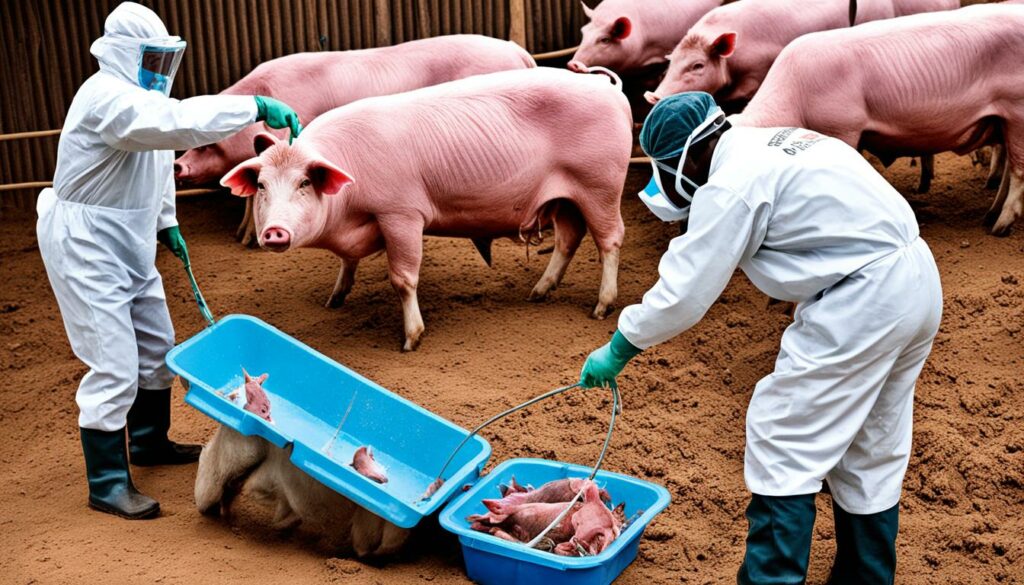
Dealing with ASF needs both ways to prevent it and to act when it happens. In Thapangtong, most families have about two pigs. One-third of these pigs roam free. But after the outbreak, movement controls were put in place to stop the disease from spreading.
Countries working together is key. For example, two villages that didn’t have ASF helped to learn more. They acted as controls in an investigation. Using phones and training for vets early detected the disease in some areas. Also, keeping track of what people understood about ASF helped to manage the outbreak better.
Looking at how ASF affects single households and whole villages is the way to go. By studying both personal and trade data, we can do better at watching and stopping ASF. This makes our strategy more useful in fighting ASF.
The highly pathogenic avian influenza (HPAI) crisis taught us much about controlling the disease. It highlighted the importance of managing avian influenza and diseases on farms.
The HPAI’s spread, especially the H5N8 virus, showed how wild birds help viruses move worldwide. It’s crucial to have strict aviculture biosecurity measures to prevent outbreaks. The recent A(H5N1) outbreak in South Korean cat shelters shows why we must stay alert. In July 2023, two shelters in Seoul found the virus, and many cats died.
The Ministry of Agriculture, Food and Rural Affairs (MAFRA) looked into the cat shelter outbreaks. They found the virus in cat food with duck meat. This food was sold to 286 customers.
Managing disease on poultry farms will face big challenges ahead. In the U.S. from 2014 to 2015, HPAI affected farms, home flocks, and wild birds. More than 50 million turkeys and chickens were hit. After HPAI confirmation, farms had to wait 111 days on average before they could restock.
| Year | Affected Premises | Personnel Deployed | Response Costs (in USD) |
|---|---|---|---|
| 2014-2015 | 211 commercial, 21 backyard | Over 3,400, including APHIS and State responders | Nearly 850 million |
Keeping strict biosecurity rules and making well-suited vaccines is key to fighting avian influenza. Being ready to innovate is crucial for facing the future challenges in poultry disease management.
Livestock diseases hit farmers hard but their effects reach much further. They cause both direct losses like decreased production and lost animals, and also indirect impacts on connected industries. Knowing these consequences helps design better policies and support for farmers.
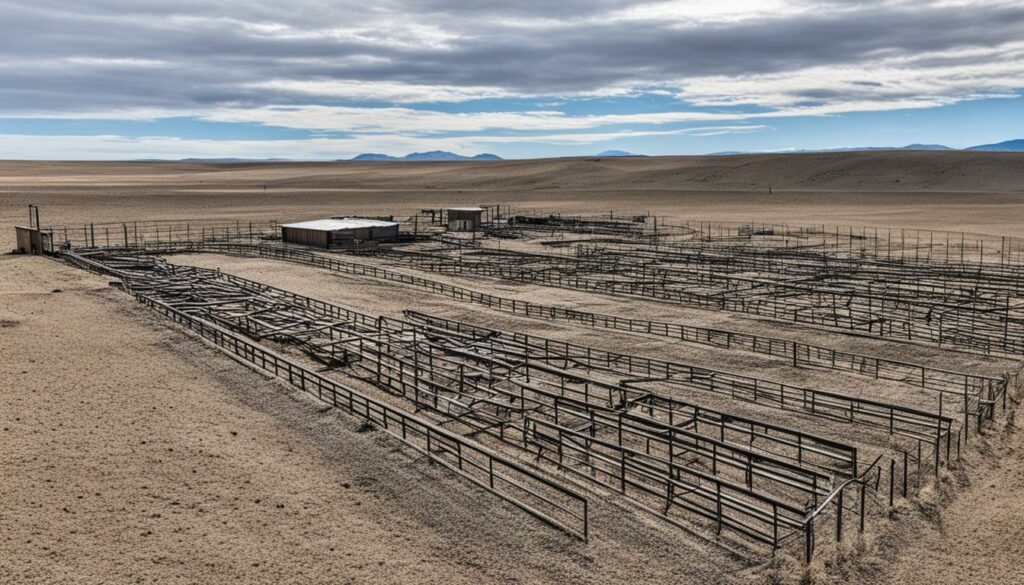
Looking back, we see how costly livestock diseases can be. For example, outbreaks of classical swine fever in Germany (1993) and the Netherlands (1994) each cost over $5 billion. The UK’s 2001 foot-and-mouth disease outbreak spent over $6 billion, nearly half a percent of the GDP. These numbers show the huge livestock disease financial impact on nations.
| Event | Year | Country | Estimated Cost |
|---|---|---|---|
| Classical Swine Fever | 1993 | Germany | $5 billion |
| Classical Swine Fever | 1994 | Netherlands | $5 billion |
| Foot-and-Mouth Disease | 2001 | United Kingdom | $6 billion |
Farmers face big challenges dealing with livestock diseases. They should invest in good biosecurity to prevent outbreaks, protecting their livestock and income. Having the right insurance can also be vital. In 2011, a study flagged up the difficult balance between economic growth and food supply, stressing the need for solid risk management in agriculture. Recent research in 2018 and 2019 highlighted the importance of readiness and financial strength, showing this with outbreaks in Nigeria’s dairy cows and Kenya’s large farms.
By improving these strategies, farmers can reduce the livestock disease financial impact. It’s key for farmers to work as a team, exchange top methods, and always be ready. This teamwork and constant readiness are essential for managing and curbing the economic effects of livestock diseases.
The tasks in veterinary disease control are vital, needing watchful eyes, prompt checks, strong treatments, and lots of teamwork in farming. Everyone from the USDA, people guiding programmes and local vets play a big part. They work together closely to tackle and lower disease outbreaks.
Numbers show how important working together is. A study found that acting fast can reduce disease spread by 75%. For diseases that can jump to humans, precautions are critical. Without them, the danger to people can spike to 90%. Speedy actions from experts cut down how many animals die by half.
30% of animal disease cases need instant announcements. They have to be reported quickly, according to rules like 9 CFR Part 161.4(f). This helps authorities move fast to stop diseases from spreading.
Farmers feel a heavy load when their animals get sick. Up to a fifth of their yearly budget can go into fighting diseases. The key is to spot, stop, and wipe out the disease. Qualified vets help at every step, working closely with monitoring groups to boost animal health and production.
Companies like APHIS have a huge job. They team up with states and businesses to boost animal health. This teamwork is vital for cutting down sickness, death, and money losses while making animals healthier overall.
Vets are a crucial line of defence against new diseases. Since the 2000s, events have shown the importance of careful vet checks and quick responses. Global agreements stress the need for both health and free trade, showing a worldwide effort for disease controls and care for livestock.
Today, keeping animals safe from diseases is crucial in agriculture. Modern tools and working together help keep animals healthy. This ensures meat, milk, and eggs are safe for us to eat.
New technology has changed how we fight diseases in farm animals. The EAIDC focuses on making tools that can find diseases early. These tools catch new threats fast, stopping big problems before they start.
CIS systems, part of NAHSS, help by watching animals closely. They are great at reducing sickness, death, and money lost. This also makes farm animals better for the market and keeps food safe for us.
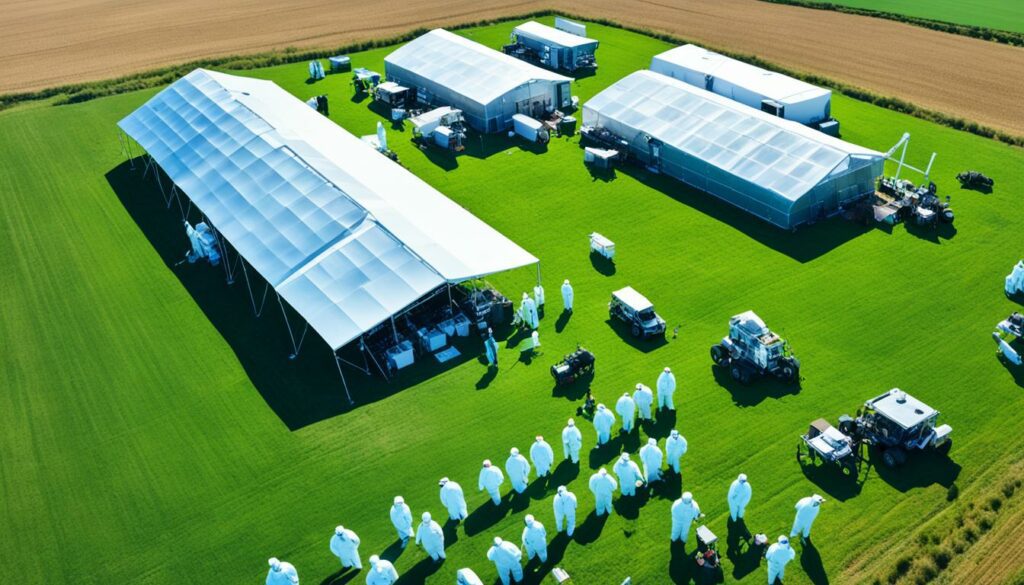
All kinds of people join hands to watch over livestock health. This includes farmers, vets, experts, and those who make the rules. Veterinarians must tell APHIS about any dangerous diseases they find, based on 9 CFR Part 161.4(f).
This teamwork makes keeping an eye on animals better. It helps us all avoid big money losses. The goal is to keep animals healthy and products safe for all.
Countries like those in the Nordics show how working together works. They’ve stayed free from very serious diseases and stopped outbreaks well. This proves that teamwork beats diseases more strongly.
Keeping good records on animal health is key. These records show when diseases are becoming a big danger. Working like this, we can spot big problems early. This keeps animals all over the world safer and healthier.
| Aspect | Description |
|---|---|
| Early Detection Tools | Next-generation pathogen diagnostics enabling timely identification of threats. |
| Comprehensive Surveillance | National Animal Health Surveillance System (NAHSS) integrates data to mitigate losses. |
| Stakeholder Collaboration | Collaboration among farmers, veterinarians, and regulatory bodies to enhance surveillance. |
| Data Collection and Utilisation | Continuous data collation aiming at early disease detection and risk prediction. |
By using technology and working together, we make the world safer for animals. These efforts help us fight diseases before they spread. This keeps animals well and our food safe.
The One Health approach looks at the health of people, animals, and the environment together. It helps in dealing with health problems that all three share. Diseases like Rabies, Salmonella, and Lyme disease affect millions of both people and animals every year. This approach shows why we must look at these health issues in a joined way.
With more mosquitoes and ticks come more diseases for us and animals. The warmer climate makes these problems worse. This shows the strong link between our health, animals’ health, and the environment. When farm animals get sick, it can hurt our food, jobs, and the economy.
By using the One Health approach, we can make better plans to stop these diseases. This approach helps us see how everything is connected.
Setting good policies about livestock diseases is very important. These policies should follow the One Health idea and encourage working together worldwide. They should think about the special bond between people and their animals, which is good for our mental health.
And, we can’t forget about how bacteria that resist medicine can spread everywhere. Using whole genome sequencing helps keep track of these dangerous bacteria in animals. This information is key for making strong, fact-based policies.
The world of veterinary medicine is always changing. New diagnostic tools are very important. Each year, nearly 1 million dogs join families in the United States and the European Union. Advanced diagnostics help us find and treat diseases in animals. This keeps our pets and farm animals healthy.
New pathogen detection methods are changing how we look after animals. They use AI and machine learning to predict and prevent health problems.
Now, vets use digital tools to diagnose, monitor, and treat animals better. Genomic sequencing and thermal imaging help find new diseases fast. These tools are key in fighting off dangerous diseases.
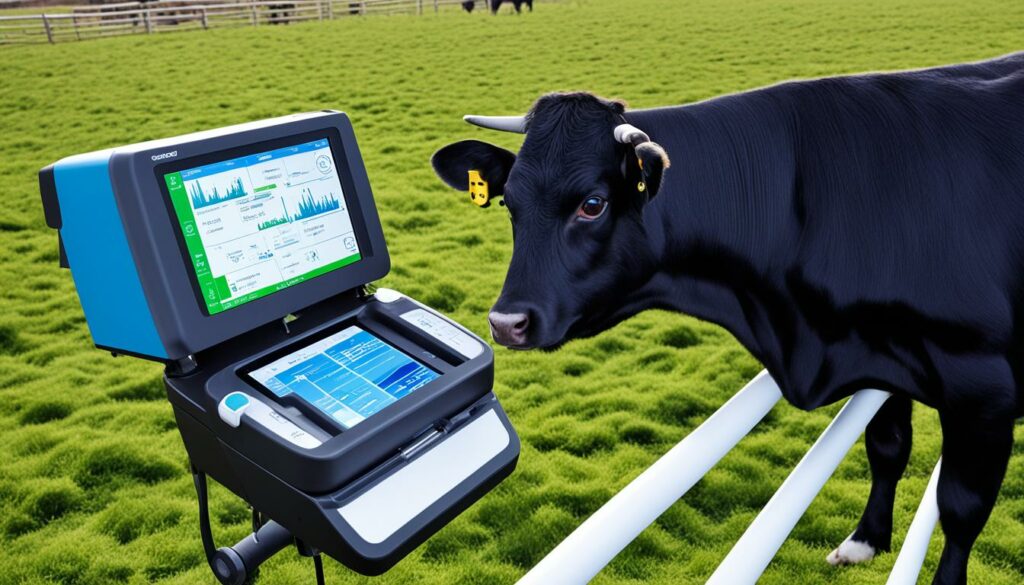
The latest tools in veterinary diagnostics are very smart. They can check an animal’s health in real time. Smart devices and sound systems help too. These make sure animals are doing well.
With new biotechnologies, we can diagnose diseases quickly and accurately. This is a big step forward from the old methods. It helps us in taking care of sick animals better and faster.
Big data is also playing a big role. It gathers health details from millions of animals. This helps vets to make the best decisions quickly. These decisions help control diseases, keeping us and our pets safe.
This digital revolution is very promising. It is not only good for animals. It helps us fight diseases smarter. It also helps keep our environment healthy. These are all part of the One Health plan. This plan looks at the health of us, our pets, and nature together.
| Key Emerging Technologies | Benefits |
|---|---|
| Genomic Sequencing | Accelerated pathogen identification |
| AI & Machine Learning | Customised care plans |
| Thermal Imaging | Early disease detection |
| Smart Ear Tags | Real-time health monitoring |
| Big Data Systems | Informed decision-making |
Keeping an eye on the health of animals is key for high productivity and to avoid diseases. Doing regular check-ups and using new data tools are great ways to keep tabs on their health. This method helps farmers spot health problems early and act fast to keep their herds healthy.
Checking on animals often is the best way to keep them healthy. Doing regular health checks allows farmers to find any sickness early. For example, in dairy cows, catching subclinical ketosis early is crucial. It affects how much milk they produce and how well they can have babies (Raboisson et al., 2014). Also, checking often can lower the chance of cows being lame. This is often because of poor living conditions and how they’re looked after (Adams et al., 2017). Taking these steps makes sure the animals are well cared for. It also protects the farm’s income.
Looking at lots of data can help spot trends and predict diseases. Let’s say, in some Kenyan dairy farms, foot-and-mouth disease has caused big losses (Reagan ABL, 2020). By digging into this kind of data, farmers can prevent similar problems in the future. Also, studies show how diseases like lumpy skin disease, Sheeppox, and Goatpox harm the economy. This info helps farmers plan better to stop these diseases (Limon et al., 2020).
Combining regular check-ups with using data is a powerful way to keep animals healthy. This strategy lets farmers make smart choices. Using stats and checking on animals’ health all the time means the farming industry can better control diseases. It also makes sure the animals are well taken care of. With the help of modern vet tools, these practices make farming effective and good for the long run.
Early detection, accurate diagnosis, and a swift response are crucial. Quarantine and vaccination are key, as is focusing on keeping farms secure. This all fights outbreaks well.
Looking after animal health stops diseases spreading. It protects our food, money, and health. Regular health checks, keeping things clean, and getting quick help when needed are all vital.
Diseases can hit economies hard, from less production to trade limits. They also harm communities by making food scarce and disrupting life.
Quick-spreading pathogens can travel far and fast, causing lots of animals to get sick or die. This hurts the economy and people, making it a big issue to control.
The 2001 foot and mouth outbreak in the UK cost over billion. In China, the ASF re-emergence hurt the global pork industry. Both cases show how serious and far-reaching livestock diseases can be.
Making sure borders are secure and cleaning transport help. Also, using good vaccines and isolating new animals helps stop diseases from spreading.
Finding problems fast means we can treat them quickly. This keeps diseases from spreading. Up-to-date tests make identifying illnesses simpler and quicker.
ASF is hard to control because it spreads quickly and is very deadly. With no vaccine, experts need strong plans and help from around the world to fight it off.
HPAI taught us that wild birds can carry and spread the virus. It stressed the need for tight security. Having the right vaccines and staying alert are key to protecting poultry farms.
They cost money from lost production and harm to related businesses. Past outbreaks have been very expensive. This is why it’s important for farmers to invest in security and have insurance.
Vets work on preventing and treating diseases, sharing info with others in agriculture. Everyone needs to team up, from farmers to officials, to keep diseases in check.
Staying on top of animal health regularly and using data to track trends are smart. When diseases are known early, action is quicker, helping both farmers and animals.